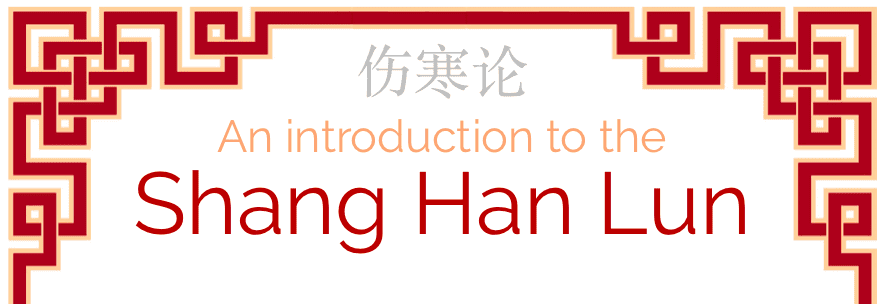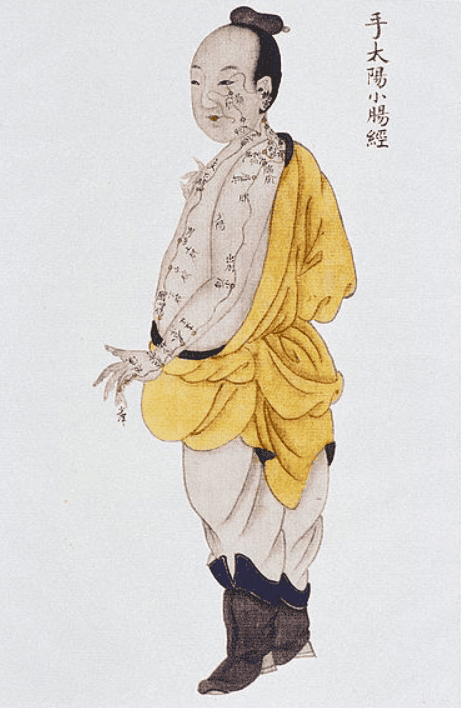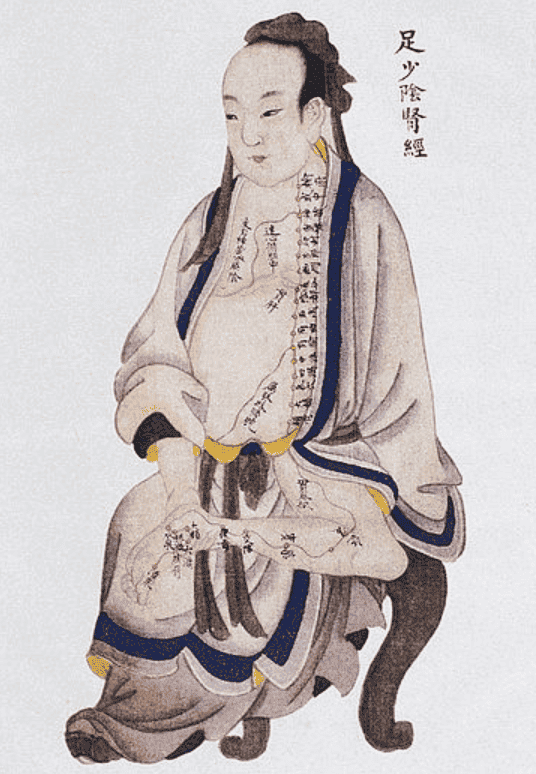 By Adam Tate
By Adam Tatewith Contributions by Robert Tan
September, 2019
(last updated July 2024)
MedicineTraditions is a subscription service for students and practitioners of Herbal and Traditional Medicine. A Unique Resource with the most comprehensive Materia Medica ever created, ‘s of Traditional Combinations and Formulas, Treatment of Disease, and ample Resources to help you become a Master.
–SUBSCRIBE NOW–
The Shang Han Lun (Treatise on Cold-Induced Disorders) is a seminal text of TCM, written approximately 200 CE by Zhang Zhong Jing. It effectively describes the progress of a pathogen from the exterior of the body (skin) down into the interior (internal organs).
It proposes that Cold, and deficient Yang Qi (Body heat) are the initial cause of acute diseases. It was formulated at a time when people lived a simple life without the benefits of modern civilization. In this time, Cold was a cause for many diseases. Later, as civilized society grew, Heat diseases (epidemic and infectious diseases) became more problematic due to density of living.
Nevertheless, the concept of supporting the Yang Qi is still popular today, and many TCM practitioners base their entire clinical practice on the formulas of Shang Han Lun. The importance of warming the body both to prevent infection and treat acute diseases can be noted in the formulas of the Ancient Greeks, Ayurveda and Tibetan Medicine too.
The system is organised in 6 stages which are associated with the meridian system. Meridians are grouped in pairs, together named as Tai Yang, Shao Yang, Yang Ming etc., and these 6 pairs represent the penetration of a pathogen from the external (Yang) to internal (Yin).
The First 3 Pairs are associated with Yang, which is more superficial. The latter 3 pairs are associated with Yin and therefore deeper. Each of the 6 Stages has representative formula used for the syndrome. A number of the formulas are also used to correct disorders associated with incorrect treatment. Altogether, there are 113 formulas in the Shang Han Lun.
The formulas are so widely used because of:
- their simplicity
- the small number of medicines used in (most of) the formulas
- the lack of obscure, expensive or animal medicines
- their elegant composition
- and most importantly, their efficacy.
This seminal text was directly responsible for widespread use of Aconite in TCM which continues to this day.
It must also be noted that many uses of the formulas have been expanded far beyond their original uses in the Shang Han Lun. For example, Xiao Chai Hu Tang is one of the most commonly prescribed formulas by many modern TCM practitioners and its modern uses are far beyond the original scope of indications mentioned in the Shang Han Lun.
The following is an overview, aimed particularly at practitioners not trained in TCM, and for students of TCM.
The Foundation Materia Medica of the Shang Han Lun
The following 10 herbs are some of the principle medicines of the Shang Han Lun formulas. Of course, numerous other herbs are used, but these herbs are used widely and in multiple formulas.
Cinnamon Twig (Gui Zhi)
Dry Ginger (Gan Jiang)
Scutellaria (Huang Qin)
Rhubarb (Da Huang)
Pinellia (Ban Xia)
Aconitum (Fu Zi)
Paeonia (Bai Shao)
Licorice (Gan Cao)
Atractylodes (Bai Zhu)
Jujube (Da Zao)
|
1. Tai Yang – Exterior Attack Meridians: Bladder & Small Intestine Meridians Key Symptoms: Floating pulse, headache, stiff neck, and a feeling of chill as seen at beginning of Cold and Influenza. Tai Yang has Two main Syndromes: 1. Wind Attack – fever and sweating, aversion to wind, pulse is moderate 2. Cold Damage (Shang Han) – aversion to Cold (with or without fever), aching pain, and a tight pulse There are several Transformed Tai Yang syndrome including Heat Disease (Wen Re Bing) – Fever, thirst, aversion to cold. Primary Treatment: Sweating |
 Small Intestine Meridian
Small Intestine MeridianImage. Wellcome Images |
|
Cinnamon twig Decoction Gui Zhi Tang Cinnamon twig (Gui Zhi) 9 grams Paeonia (Bai Shao) 9 grams Fresh Ginger (Sheng Jiang) 9 grams Jujube (Da Zao) 9–12 pieces Fried Licorice (Zhi Gan Cao) 6 grams This is especially indicated for Wind Attack (1) Associated Formula: Ge Gen Tang, add Ephedra Ma Huang, Pueraria Ge Gen for stiffness in the neck and back. |
Ephedra Decoction Ma Huang Tang Ephedra (Ma Huang) 6 grams Cinnamon twig (Gui Zhi) 4 grams Bitter Apricot kernel (Xing Ren) 9 grams Fried Licorice (Zhi Gan Cao) 3 grams *Ephedra is decocted first, removing the foam from the surface before adding the other herbs. This is used for Cold Attack (Shang Han) (2) Headache, Fever, general body aches, arthralgia, aversion to Wind, Asthma without Sweating In modern times, often used for Influenza (from Cold), Chronic Bronchitis, Bronchial Asthma. Contraindications: * Dry, sore throat • Strangury, Bleeding * Sweating, especially spontaneous sweating from deficiency * Palpitations |
Transformed Tai Yang Syndrome:
These are syndromes which develop after initial Tai Yang syndrome. A detailed account is beyond the scope of the current work.
|
A. HEAT SYNDROME: Zhi Zi Duo Chi Tang B. COLD SYNDROME i. Heart Yang Deficiency Gui Zhi Gan Cao Tang Gui Zhi Jia Long Gu Mu Li Tang ii. YANG DEFICIENCY WITH WATER RETENTION: Ling Gui Zhu Gan Tang C. SPLEEN DEFICIENCY Xiao Jian Zhong Tang |
D. KIDNEY YANG DEFICIENCY Zhen Wu Tang E. YIN AND YANG DEFICIENCY Bai Shao Gan Cao Tang (Muscular Spasms) Zhi Gan Cao Tang (Heart Yin and Yang Deficiency, Palpitations) F. WATER RETENTION OF TAI YANG Wu Ling San G. BLOOD STASIS: Tao He Cheng Qi Tang |
Other Tai Yang Formula:
|
Da Qing Long Tang Major Bluegreen Dragon Decoction A variation of Ma Huang tang –Cough with Interior Heat and external Cold (or Common cold in a hot constitution) Ephedra (Ma Huang) 12 grams Cinnamon twig (Gui Zhi) 4 grams Apricot kernel (Xing Ren) 9 grams Gypsum (Shi Gao) 12 grams Fried Licorice (Zhi Gan Cao) 3 grams Fresh Ginger (Sheng Jiang) 9 grams Chinese Date (Da Zao) 3 pieces Xiao Qing Long Tang Minor Bluegreen Dragon Decoction –Cough with Phlegm and exterior Cold. (or Common Cold in phlegm constitution) Ephedra (Ma Huang) 9 grams Cinnamon twig (Gui Zhi) 9 grams Dry Ginger (Gan Jiang) 9 grams Asarum (Xi Xin) 9 grams Schisandra (Wu Wei Zi) 9 grams Paeonia (Bai Shao) 9 grams Pinellia (Ban Xia) 9 grams Fried Licorice (Zhi Gan Cao) 9 grams |
Ma Xing Gan Shi Tang Ephedra, Apricot Kernel, Gypsum and Licorice Decoction –Asthma with sweating, but without high Fever Ephedra (Ma Huang) 12 grams Gypsum (Shi Gao) 48 grams Apricot kernel (Xing Ren) 12–18 grams Fried Licorice (Zhi Gan Cao) 6 grams Bai Hu Jia Ren Shen Tang White Tiger and Ginseng Decoction –after Gui Zhi Tang, patient still has thirst and sweating Gypsum (Shi Gao) 12 grams Anemarrhena (Zhi Mu) 9 grams Rice (Geng Mi) 9–15 grams Fried Licorice (Zhi Gan Cao) 3 grams Ginseng (Ren Shen) 3–9 grams Ge Gen Huang Qin Huang Lian Tang Kudzu, Scutellaria and Coptis Decoction –severe diarrhea after purging in an acute disease, rapid pulse Pueraria (Ge Gen) 15–24 grams Coptis (Huang Lian) 9 grams Scutellaria (Huang Qin) 6 grams Fried Licorice (Zhi Gan Cao) 6 grams |
2. Yang Ming – Heat in the Stomach & Intestines
Meridians: Stomach and Large Intestine Meridians
Yang Ming indicates Stomach and Intestine excess. It may be in the Yang Ming Channels (Meridians) in which there is heat felt throughout the body. If in the Yang Ming organs (Stomach and Intestines) there is Stomach Heat with heat of the Stool which may cause Constipation or dry Stool.
Key Symptoms: aversion to heat, fever, sweating, thirst with desire to drink, abdominal fullness, distention, and pain, constipation, maybe delirious speech
Primary Treatment: Draining, Purging
|
A. Yang Ming Channel Syndrome: White Tiger Decoction Bai Hu Tang Gypsum (Shi Gao) 30 grams Anemarrhena (Zhi Mu) 9 grams Baked Licorice (Zhi Gan Cao) 3 grams Rice (Geng Mi) 9–15 grams White Tiger plus Ginseng Decoction Bai Hu Jia Ren Shen Tang Gypsum (Shi Gao) 30 grams Anemarrhena (Zhi Mu) 9 grams Baked Licorice (Zhi Gan Cao) 3 grams Rice (Geng Mi) 3–9 grams Ginseng (Ren Shen) 3–9 grams Clears Interior Heat, generates Fluids; used for Fever with deficiency. Also used for Diabetes with heat symptoms. |
B. Yang Ming Organ Syndrome: Minor Order the Qi Decoction Xiao Cheng Qi Tang Rhubarb (Da Huang) 12 grams Magnolia bark (Hou Po) 6 grams Immature Orange (Zhi Shi) 6 grams Stomach fullness and excess that isn’t too extreme Major Order the Qi Decoction Da Cheng Qi Tang Rhubarb (Da Huang) 12 grams Magnolia bark (Hou Po) 12 grams Mirabilite (Mang Xiao) 9 grams Immature Orange (Zhi Shi) 9 grams Yang Ming disorder with dry stool and excess; Severe constipation, abdominal fullness and pain that increases with pressure, dry, yellow tongue coat Contraindications: Stomach Coldness, Vomiting |
C. Yang Ming Syndrome with Jaundice:
|
Artemisia Yin Chen Decoction Yin Chen Hao Tang Artemisia (Yin Chen) Gardenia (Zhi Zi) Rhubarb (Da Huang) |
Gardenia and Phellodendron Decoction, Zhi Zi Bai Pi Tang Gardenia (Zhi Zi) Phellodendron (Huang Bai) Licorice (Gan Cao) |
3. Shao Yang – Pathogen penetrates Deeper
|
Meridians: Gall Bladder and Triple Warmer Meridians Heat in the Gall Bladder, Qi stagnation with Spleen and Stomach affected. At this stage the pathogen is between the external (Tai Yang) and internal (Yang Ming) which is why there is alternating Fever and Chill. Key Symptoms: Alternate Fever and Chill, bitterness in the mouth, a dry throat, alternating aversion to cold and fever, chest and hypochondria distention, no desire to eat or drink, heart vexation, Vertigo, pulse is thin and wiry. Primary Treatment: Harmonizing |
 Triple Warmer Meridian
Triple Warmer MeridianPhoto: Wellcome Images |
|
Lesser Bupleurum Decoction Xiao Chai Hu Tang Bupleurum (Chai Hu) 12 grams Scutellaria (Huang Qin) 9 grams Ginseng (Ren Shen) 6 grams Pinellia (Ban Xia) 9 grams Fried Licorice (Zhi Gan Cao) 9 grams Fresh Ginger (Sheng Jiang) 9 grams Jujubes (Da Zao) 4 pieces |
Greater Bupleurum Decoction Da Chai Hu Tang Bupleurum (Chai Hu) 9 grams Scutellaria (Huang Qin) 9 grams Pinellia (Ban Xia) 9 grams Paeonia (Bai Shao) 9 grams Immature Orange (Zhi Shi) 9 grams Fresh Ginger (Sheng Jiang) 9 grams Jujubes (Da Zao) 4 pieces Rhubarb (Da Huang) 6 grams |
4. Tai Yin – Spleen Yang Deficiency
Meridians: Lung and Spleen Meridians
Poor digestion and low appetite, Diarrhea without Thirst, caused by Deficiency Cold (Yang Deficiency).
Key Symptoms: Abdominal fullness and pain, diarrhea, vomiting, pulse is moderate or weak with a pale tongue and a white coating.
It can be caused by incorrect purging which causes Spleen Yang deficiency.
If there are exterior symptoms, aversion to cold, sweating etc., use Gui Zhi Tang (above)
Primary Treatment: Warming
|
Warm the Middle Pills Li Zhong Wan Atractylodes (Bai Zhu) 9 grams Ginseng (Ren Shen) 9 grams Fried Licorice (Zhi Gan Cao) 6–9 grams Dry Ginger (Gan Jiang) 9 grams Warms and Strengthens the Stomach and Spleen, tonifies Qi, clears Cold, warms the Yang. For more extreme Coldness and Yang deficiency, Aconitum Fu Zi is added, and this is called Fu Zi Li Zhong Wan (Aconite Warm the Middle Pills) Frigid Extremities Decoction Si Ni Tang Aconite prepared (Fu Zi) 6–9 grams Ginger (Gan Jiang) 4.5 grams Fried Licorice (Zhi Gan Cao) 6 grams Severe Cold and Yang deficiency manifesting with Cold extremities. |
Minor Construct the Middle Decoction Xiao Jian Zhong Tang Maltose (Yi Tang) 30 grams Cinnamon twig (Gui Zhi) 9 grams Paeonia (Bai Shao) 18 grams Fried Licorice (Zhi Gan Cao) 6 grams Fresh Ginger (Sheng Jiang) 9 grams Jujube (Da Zao) 4 pieces Warms the Stomach and Spleen, stops Spasm and relieves Pain. For Spasmodic Abdominal Pain that is relieved warmth. |

5. Shao Yin – Heart and Kidney Deficiency
|
Meridians: Heart and Kidney Meridians In a more critical stage, the pathogens attack the Heart and Kidney. Key Symptoms: Absence of heat, aversion to cold, cold limbs, diarrhea with undigested food, feeble and weak pulse, tendency for the patient to fall asleep. Further, it is divided into Hot and Cold types (which is due to the constitution of the patient): A. COLD TYPE: Heart and Kidney Yang Deficiency: Weak and feeble pulse, chills but no Fever, vomiting, diarrhea with Cold, cold extremities, clear and prolonged urination, pale tongue with white coat. Primary Treatment: Warming B. HEAT TYPE (from Deficient Yin): Kidney Yin Deficiency: Anxiety, insomnia, red tongue, thready and rapid pulse. Primary Treatment: Nourish Yin |
 Kidney Meridian
Kidney MeridianPhoto: Wellcome Images |
|
A. Cold Type: Frigid Extremities Decoction Si Ni Tang Aconite prepared (Fu Zi) 6–9 grams Ginger (Gan Jiang) 4.5 grams Fried Licorice (Zhi Gan Cao) Used for Internal Coldness and Yang deficiency. Aconite Decoction Fu Zi Tang Aconitum (Fu Zi) 12–18 grams Atractylodes (Bai Zhu) 12 grams Poria (Fu Ling) 9 grams Ginseng (Ren Shen) 6 grams Paeonia (Bai Shao) 9 grams Yang deficiency with Coldness, body pain, aching bones and joints, cold extremities; or for Coldness with both Yin and Yang deficiency. True Warrior Decoction Zhen Wu Tang Aconitum (Fu Zi) 9 grams Poria (Fu Ling) 9 grams Atractylodes (Bai Zhu) 6 grams Fresh Ginger (Sheng Jiang) 9 grams Paeonia (Bai Shao) 9 grams Yang deficiency with Cold, Damp and Fluid obstruction, cold abdominal pain, pain of extremities, generalised Edema. |
B. Heat Type: Coptis and Ass Geletin Decoction Huang Lian E Jiao Tang Coptis (Huang Lian) 12 grams Scutellaria (Huang Qin) 6 grams Paeonia (Bai Shao) 6 grams Egg Yolks (2) Ass Gelatin (E Jiao) 9 grams Evodia Decoction Wu Zhu Yu Tang Evodia (Wu Zhu Yu) 9–12 grams Ginseng (Ren Shen) 9 grams Fresh Ginger (Sheng Jiang) 18 grams Jujube (Da Zao) 12 pieces Nausea, vomiting, diarrhea from Deficient Cold, or Coldness of the Liver. Similar to the syndrome for which Li Zhong Wan is used, but without as much Dampness.. |
6. Jue Yin – Cold & Heat
Meridians: Liver and Pericardium Meridians
Three different syndromes are covered by Jue Yin:
A. Heat in the Upper, Cold in the Lower–Yang is weak, Yang floats upwards
B. Cold Extremities–Yang Qi blocked
C. Vomiting from Liver Cold
A. Heat in the Upper and Cold in the Lower
Thirst, qi surging up to the heart, pain and vexation in the heart, heat and pain of the stomach, hunger with no desire to eat, and vomiting of roundworms, frequent urination
|
Mume Pill Wu Mei Wan Mume fruit (Wu Mei) 30 grams Sichuan Pepper (Hua Jiao) 6 grams Asarum (Xi Xin) 3 grams Coptis (Huang Lian) 6 grams Phellodendron (Huang Bai) 6 grams Aconitum (Fu Zi) 6 grams Cinnamon twig (Gui Zhi) 6 grams Ginger (Gan Jiang) 9 grams Ginseng (Ren Shen) 6 grams Dang Gui 6 grams Heat above, cold below; extreme cold hands and feet (from blocked Yang Qi); chronic Diarrhea or Dysentery. Also for Roundworms. |
Ginger, Coptis, Scutellaria, and Ginseng Decoction Gan Jiang Huang Qin Huang Lian Ren Shen Tang Ginger (Gan Jiang) 6–9 grams Coptis (Huang Lian) 3–6 grams Scutellaria (Huang Qin) 6–9 grams Ginseng (Ren Shen) 6 grams Digestive disorders with poor appetite, thirst, epigastric pain, bitter taste, acid regurgitation. Ephedra and Cimicifuga Decoction Ma Huang Sheng Ma Tang
|
B. Cold Extremities
|
Frigid Extremities Decoction Si Ni Tang Aconite prepared (Fu Zi) 6–9 grams Ginger (Gan Jiang) 4.5 grams Fried Licorice (Zhi Gan Cao) 6 grams Cold extremities from Yang deficiency and Coldness |
Dang Gui Frigid Extremities Decoction Dang Gui Si Ni Tang Angelica (Dang Gui) 9 grams Paeonia (Bai Shao) 9 grams Cinnamon (Gui Zhi) 9 grams Asarum (Xi Xin) 6 grams Jujubes (Da Zao) 25 pieces Fried Licorice (Zhi Gan Cao) 6 grams Akebia (Mu Tong) 6 grams Cold and Damp affecting the Blood, causing Cold extremities. |
|
C. Vomiting from Liver Cold: Evodia Decoction Wu Zhu Yu Tang Evodia (Wu Zhu Yu) 9–12 grams Ginseng (Ren Shen) 9 grams Fresh Ginger (Sheng Jiang) 18 grams Jujube (Da Zao) 12 pieces Vomiting from Liver Cold, opposed to Li Zhong Wan which is used for Vomiting from Stomach Cold. |
Conclusion
The Shang Han Lun is a seminal text in TCM and is still remarkably relevant today. Many of the formulas are used for a variety of conditions outside the realm of their original intended use, and this demonstrates that they are effective and well composed formulas.
It is interesting to note that the text has little explanation of theory or explanation of Materia Medica, rather it gives syndromes (collection of symptoms) along with appropriate formulas. This suggests that many of these formulas and their original uses can be applied by non-TCM practitioners as there is not really a detailed TCM knowledge requirement to use such formulas. It is also useful for non-TCM practitioners to study the progression of an acute or external disease to deeper within the body.
You may also like:
15 Powders to Warm the Stomach
Chinese Medicine in European Texts
Chinese Medicines used in the West before TCM
VPK – a useful way to understand Materia Medica
115 Herbs Common to Western and Chinese Medicine
